Publisher’s Note: AAQ / East End is not a nonprofit organization — however, AAQ posts 125+ announcements monthly from cultural nonprofit organizations on the East End at no charge to those organizations — and AAQ prepares exclusive portfolios (100+) on art, architecture, preservation & historic sites at its own expense.
As a grassroots online publication, Donations, Resource Plate ads or Portfolio Sponsorships to sustain its mission would be greatly appreciated.
DONATE
Resource Plate inquiries for specs, rates, further information: info@aaqeastend.com
Thank you!
~~~~~~~~~~~~~~~~~~~~~~~~~~~~~~~~~~
Ransome’s Japanese Bridge & Sea Wall
Smith Cove, Shelter Island
~~~~~~~~~~~~~~~~~~~~~~~~~~~~~~~~~~~~~~~~~~~~~~~~~
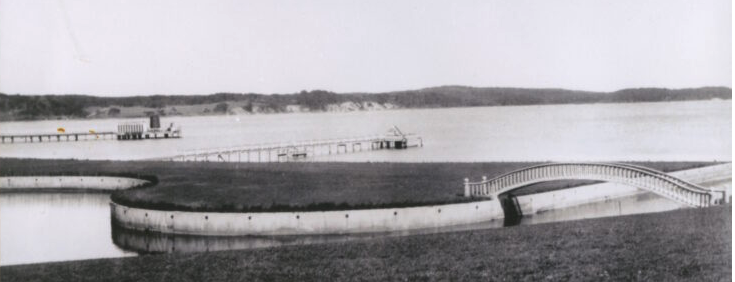
Ransome’s Japanese Bridge & Sea Wall off Smith Cove, Shelter Island / Archival Photo c. 1910.
~~~~~~~~~~~~~~~~~~~~~~~~~~~~~~~~~~~~~
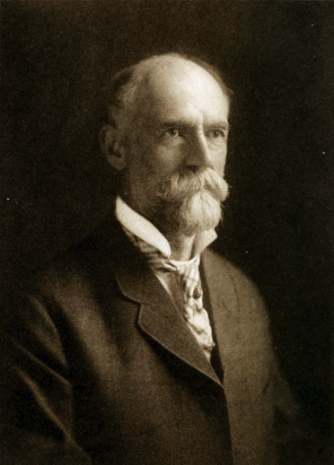
The two historic structures – the bridge and associated sea wall – are constructed of reinforced concrete and were the work of the renowned engineer and inventor Ernest L. Ransome. The remnants of a dike separating the lagoon from the basin and a lock where the historic channel met Smith Cove are part of the sea wall and together these features created the lagoon. Both the wall and the bridge demonstrate the viability of the original construction materials, however, and have withstood the negative effects of adverse weather and numerous hurricanes, such as that of 1938, which led to the demolition of the Francis Marion Smith’s estate house, “Presdeleau.”
————————-
National Register Status Awarded/ February 2nd, 2018
~~~~~~~~~~~~~~~~~~~~~~~~~~~~~~~~~~~~~
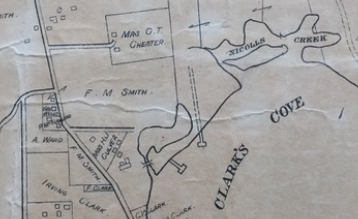
Archival Map showing Francis M. Smith property on Clark’s Cove, now Smith’s Cove.
Japanese Bridge, Lagoon, Docks & location of Smith’s estate house, Presdeleau (destroyed in the hurricane of 1938).
~~~~~~~~~~~~~~~~~~~~~~~~~~~~~~~~~~~~~
Francis Marion Smith
 In the mid-1990s, F.M. Smith, owner of the Pacific Coast Borax Company (20 Mule-Team Borax) commissioned the inventor and engineer Ernest Ransome to design and build a lagoon with reinforced concrete walls, tidal gates for maintaining the lagoon’s depth at low tide, and a graceful closed-spandrel arched bridge in the Japanese Style.
In the mid-1990s, F.M. Smith, owner of the Pacific Coast Borax Company (20 Mule-Team Borax) commissioned the inventor and engineer Ernest Ransome to design and build a lagoon with reinforced concrete walls, tidal gates for maintaining the lagoon’s depth at low tide, and a graceful closed-spandrel arched bridge in the Japanese Style.
This “Japanese Bridge” as it has come to be known is thus among the earliest ferro-concrete structures ever built and is perhaps the most graceful bridge of the early structures. It is also set in a uniquely designed lagoon that continues to be used as a boat basin by residents of the community on Shelter Island.
~~~~~~~~~~~~~~~~~~~~~~~~~~~~~~~~~~~~~
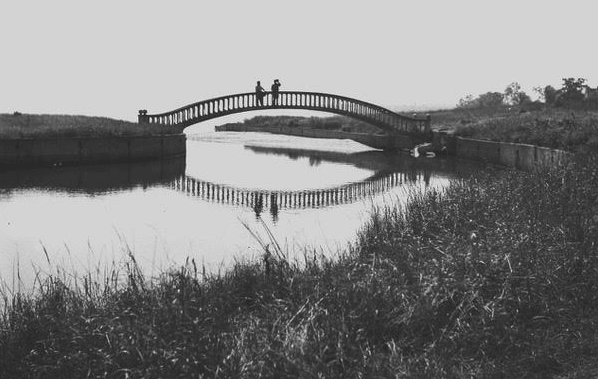
~~~~~~~~~~~~~~~~~~~~~~~~~~~~~~~~~~~~~
The Art of the Japanese Bridge
The design of the bridge that arches over this lagoon follows the concept that is known in both Japan and China as a Moon or Drum Bridge: a ‘Taiko Bashi’ in Japanese. The reason for this name is that it is shaped as a half circle or half-moon and built over a reflecting pool so that when the light is right the reflection fills out the half-circle and a full moon shape appears instead. The bridges are often found in Japanese tea gardens and are generally made out of wood. Ours instead is made out of steel reinforced concrete. It is probably the first moon bridge ever made in this way. That it is still standing and usable as a foot bridge after over 100 years near the sea and salt water, surviving both hurricanes like that of 1938 and Shelter Island winters is an engineering marvel.
Tea Gardens are designed to promote contemplation and reflection. The Moon Bridge engenders reflection in both the literal and the figurative sense. There is the literal reflection of the half-circle in the pool, but it is also true that when you walk over a moon bridge the steepness of the arch causes you to pause at the top. It is a little bit of a climb to get over it and invariably when you get to the crest of the span, you stop and reflect.
— from a talk by David Lichtenstein, PhD
President of South Ferry Hills Association / July 7, 2019.
~~~~~~~~~~~~~~~~~~~~~~~~~~~~~~~~~~~~~
The Japan Craze: Aesthetic Influence in the Victorian Age
The Japanese Bridge design was inspired by the “Japan Craze,” or Japonisme, which pervaded Western culture in the late 19th and early 20th century. The style was fueled in large part by the exotic nature and source of artworks, porcelain and other objects which found their way to European and American markets. Notable among these were ukiyo-e, Japanese woodblock prints, which became an inspiration for Western artists because of their use of color, dramatic foreshortening and asymmetrical composition. Impressionist painters and contemporary designers such as Louis Comfort Tiffany (1848-1933) were especially influenced by Japanese art and design, and Vincent van Gogh (1853-1890), who collected ukiyo-e prints and organized a Japanese print exhibition in Paris in 1887, was also a major proponent.
Van Gogh’s contemporary, the impressionist painter Claude Monet (1840-1926), was inspired by the craze19 and may have been familiar with Josiah Conder’s Landscape Gardening in Japan, published in 1893. Monet’s garden at Giverny, laid out that year, featured a Japanese footbridge spanning a pool of water lilies, and became a subject that the artist painted numerous times. The bridge itself, which appears to be built of wood with simple railings, spans the pond in a shallow arch, and while reminiscent of the Japanese bridge type known as soribashi, is in reality only one of many types which were also flat and built of various materials, including stone and logs. The enduring and graceful profile of Monet’s “Japanese” footbridge established a prototype, however, and Ransome’s bridge on Shelter Island found its precedent in this form.
— Summary Statement Excerpt
National Register of Historic Places
~~~~~~~~~~~~~~~~~~~~~~~~~~~~~~~~~~~~~
Smith – Ransome Japanese Bridge / Historical Significance
The pedestrian bridge on Shelter Island is a valuable example of engineering ingenuity from the early 20th Century. It is an elegant crossing of the inlet that belies its strength; the fact that the structure survived the hurricane that destroyed Presdeleau is a testament to its robustness. Ernest L. Ransome is a very significant figure in the history of structural engineering in the reinforced concrete world. His innovations were used by many other engineers in the late nineteenth and early twentieth centuries, and adapted to increase the range and variety of structures that could be built using reinforced concrete.
The general principal of reinforced concrete is that by embedding strands of steel within a mass of concrete, under the right positioning and numbers of bars, you create a monolithic hybrid with strength in compression, tension and shear (concrete has very low tensile strength compared to compressive strength). In order for this to work, the bars must be a well bonded to the concrete in order to develop the tension without “slipping.” ….
— Old Structures Engineering — Marie Ennis, PE
~~~~~~~~~~~~~~~~~~~~~~~~~~~~~~~~~~~~~
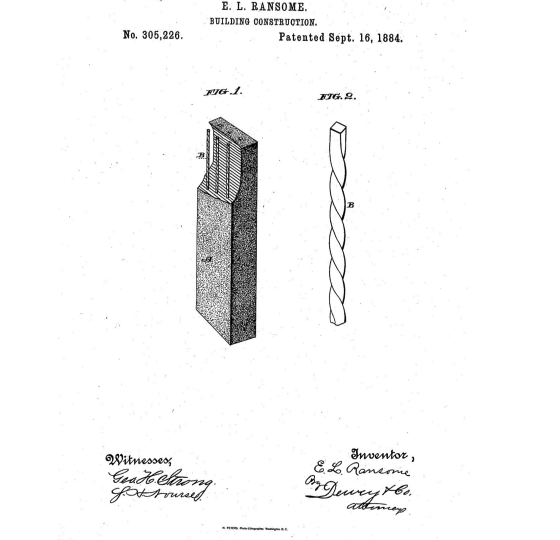
~~~~~~~~~~~~~~~~~~~~~~~
Smith – Ransome Japanese Bridge / Ransome Bars aka Rebars
Construction of the bridge used reinforced concrete technology that was uncommon in its day, employing iron reinforcing bars composed of twisted “rebars” known as “Ransome bars,” which had a square cross-section, set in hand-mixed concrete, and hand-formed and cast in place. The surface of the bridge deck is cast concrete impressed with a brick pattern. The balusters alternate with elongated, rounded openings arranged vertically to follow the curve of the bridge deck. The cross section of the balusters includes a reverse 1⁄4 round edge detail on both interior and exterior sides.
The bridge measures approximately 60’ long by 6’ wide at each end. The arched deck narrows to 4’ wide at its center, where it reaches a height of about 10’ feet above the water. The deck is arched not only from end to end, but also from side to side, enabling water to flow downward into drains located adjacent to the posts. Each of the four turned concrete posts situated at the base of the bridge stands 4’ high and the balustrades that extend along each side of the deck are 3’ high. The balusters are spaced 12” on center. The “bricks,” which are impressed as a pattern in the deck, measure 2 1⁄2” by 9.”
— Excerpt National Register Application
~~~~~~~~~~~~~~~~~~~~~~~~~~~~~~~~~~~~~
Smith – Ransome Japanese Bridge / Overviews
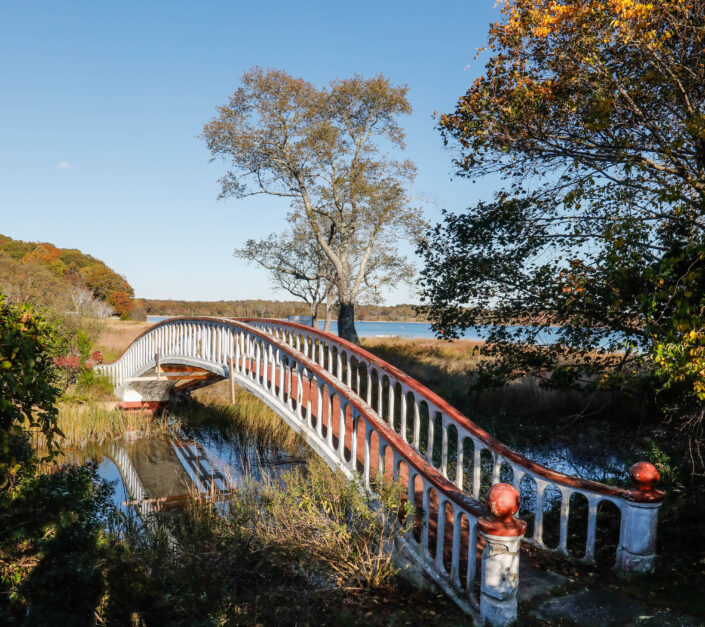
~~~~~~~~~~~~~~~~~~~~~~~~~~~~~~~~~~~~~~~~~~~~~~~~
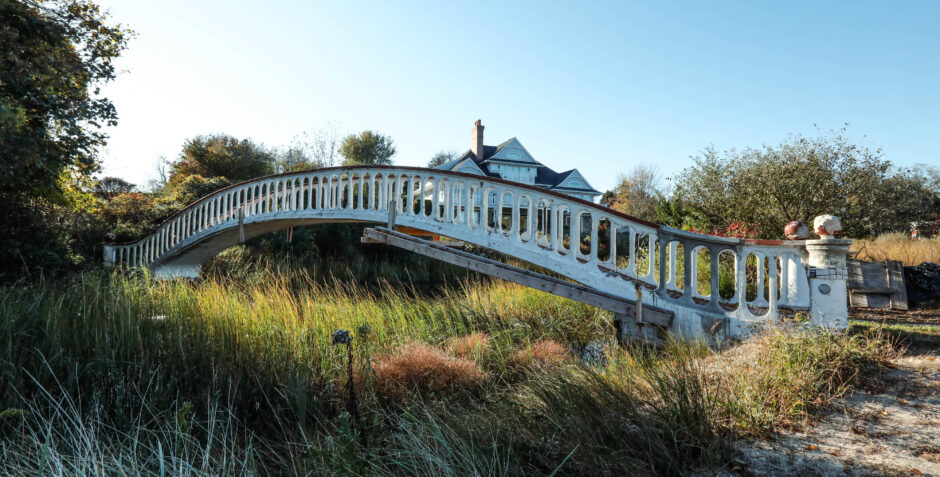
House in the distance is where Francis Marion Smith’s estate house, Presdeleau, was situated.
~~~~~~~~~~~~~~~~~~~~~~~~~~~~~~~~~~~~~
Smith – Ransome Japanese Bridge / Details
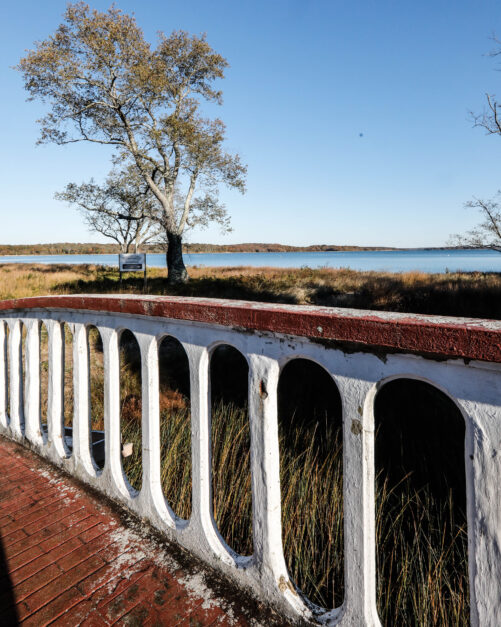
~~~~~~~~~~~~~~~~~~~~~~~~~~~~~~~~~~~~~~~~~~~~~~~~
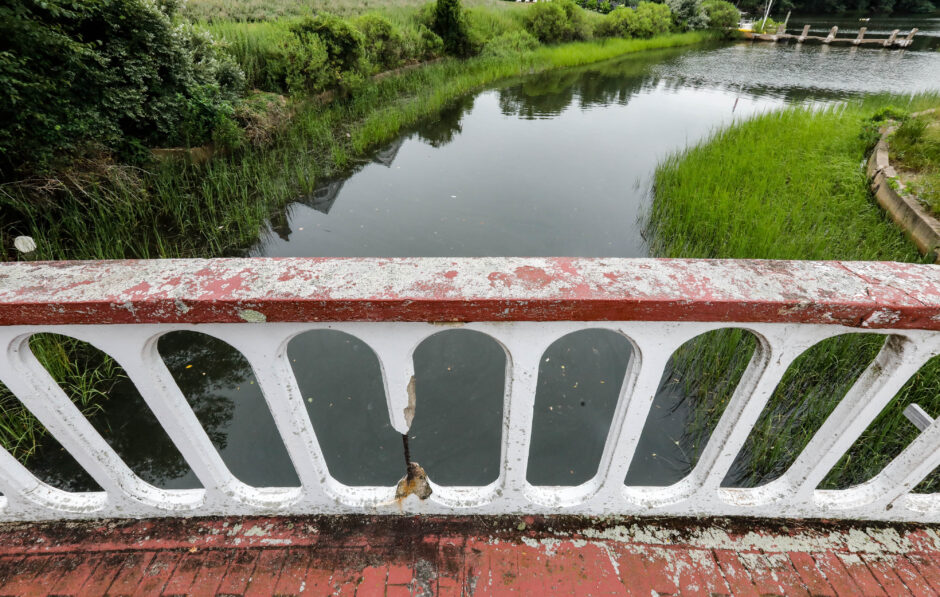
E.L. Ransome’s Twisted Iron Rebar visible in this eroded Baluster.
~~~~~~~~~~~~~~~~~~~~~~~~~~~~~~~~~~~~~~~~~~~~~~~~
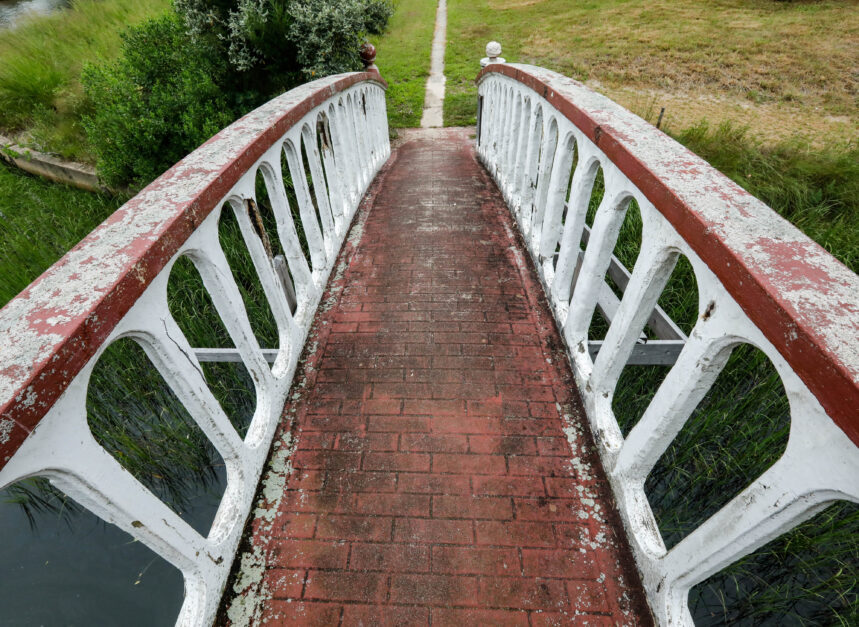
~~~~~~~~~~~~~~~~~~~~~~~~~~~~~~~~~~~~~~~~~~~~~~~~
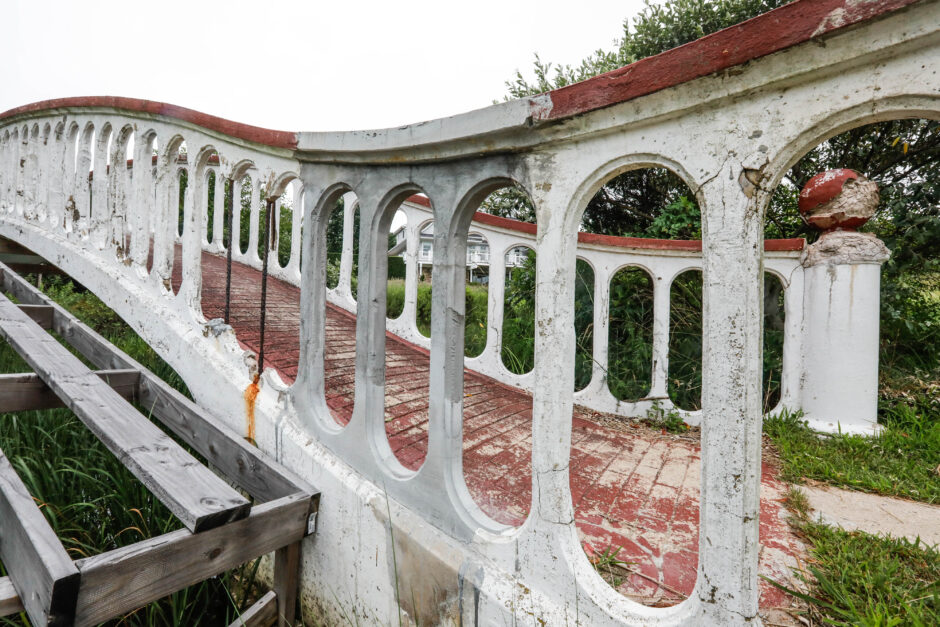
~~~~~~~~~~~~~~~~~~~~~~~~~~~~~~~~~~~~~~~~~~~~~~~~
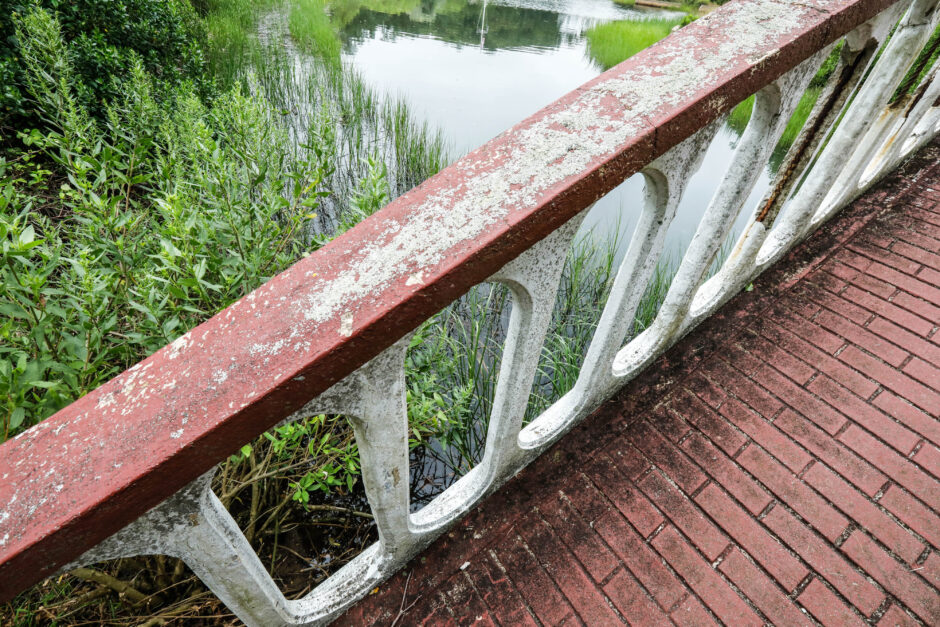
~~~~~~~~~~~~~~~~~~ ARCHIVAL ~~~~~~~~~~~~~~~~~~
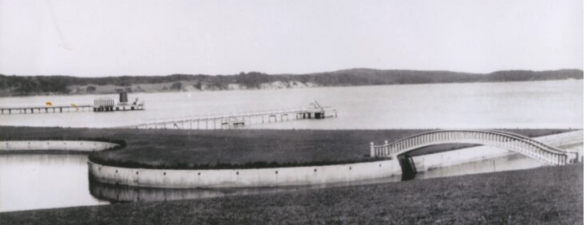
View from Francis Marion Smith’s estate house, “Presdeleau.”
————————

F.M. Smith’s Steam Yacht, Hauoli, 1903. Designer: H.J. Gielow. Built 1903 by J.N. Robins.
————————

